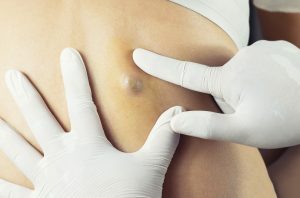Wondering when to get a skin mole checked by a professional? Dr Skin Surgery are here to explain all about moles and how to check them.

Whilst most skin moles are safe, it is important to be aware of what a ‘normal’ mole looks like, along with the abnormalities to look out for. In this article, we explainwhat skin moles are, the different types of skin moles, the warning signs of melanoma (cancer), how to examine your moles, as well as how skin moles can be removed by a professional.
What is a Skin Mole?
Moles – also referred to medically as nevi – are common skin growths that appear as coloured spots that vary in size and shape. By adulthood, it is normal for an individual to have between 10 and 40 moles, and they can develop anywhere on the body from the scalp and armpits to between fingers and toes. It is not uncommon for moles to slowly change year on year – perhaps becoming raised or appearing lighter in colour
– although some may not change at all or even slowly disappear.

Typical moles are simply a group of normal melanocytes – specialised skin cells that produce the protective
skin-darkening pigment melanin. Most moles are completely harmless. However, on rare occasions,
if their DNA becomes damaged they can turn cancerous. This is called melanoma.
What are the Different Types of Skin Moles?
- Common Nevi: These are considered to be ‘normal’ moles, e. a small skin growth with a distinct edge that varies in colour from pink and tan all the way to brown
- Congenital Nevi: Occurring in about 1 in 100 people, these are moles that an individual has had since birth and are more likely to develop into melanoma than moles that appear after birth
- Dysplastic Nevi: These moles are larger than usual and are irregular in both shape and colour and tend to be inherited. Dysplastic Nevi have a greater chance of developing into a malignant melanoma – which is cancerous, so if there are any changes, you should consult a professional skin doctor.
When Should You See a Doctor About a Mole?
Most moles are safe and normal. However, it is important to get a new or existing mole checked by a professional. This is particularly the case if,- over a period of weeks or months, the mole:
- Changes shape or appears uneven; or
- Changes colour, becomes darker or contains more than two colours; or
- Begins to itch, crust, flake, bleed, gets larger or becomes more.

skin exams from a doctor or dermatologist critical, especially if you are at high-risk.
How to Examine Yourself for Skin Moles
Try to stay aware of any changes in your moles and other pigmented areas of your skin, looking out for signs of malignant melanoma (skin cancer). You may want to take regular pictures of any new or existing mole that you are worried about so that you can easily and effectively track changes in its shape, size, colour and texture. Read more about how to examine your moles.
How to Prevent Moles from Occurring
Moles most commonly occur in places that are exposed to UV light frequently. Therefore, taking measures to protect yourself from damage such as using suncream daily and avoiding sun beds will help. Try to stay in the shade between 11 am and 3 pm when sunlight is strongest, and cover the skin – especially your moles – with long sleeved clothes clothes and your head with wide brimmed hats to provide a barrier.
Treatment of Skin Moles: How are Moles Removed?
Skin moles can be removed using a variety of methods. The method usedwill depend on several factors including the size, shape of the mole. There are two main methods that can be used
- Surgical Excision: This involves cutting the mole outwith a scalpel or sharp, circular blade and some of the skin around it before stitching the skin closed
- Curettage and Cautery: For smaller moles, Curettage and Cautery may be This is a type of electrosurgery. After the skin has been curetted (smoothed), an electrical device is lightly used to cauterize (burn) the skin.
The procedures can be relatively quick, often with incredibly smooth results, if carried out by a trusted professional. Whenever approaching a professional about a mole, ideally, a consultation should be offered in the first instance, to enable the doctor to assess the mole and to consider the best treatment option for youAfter the removal, we would suggest that all lesions are sent to laboratory for a full histological report to test tell us what the result was and to rule out any worrying things like skin cancer.
The Bottom Line
The most important warning sign of malignant melanoma or skin cancer is a new spot (or mole) on the skin or one that is changing in size, shape, or colour. If this is the case, we advise you to go and see your GP. If your mole is deemed to be harmless, it will not usually be treated on the NHS because it will be considered cosmetic, meaning that you may want to get in touch with a private clinic in order to get it removed safely and effectively.
At Dr. Skin Surgery, we are the best point of consultation for skin mole removal surgery in the London and surrounding area. Our expert team of doctors will effectively assess any moles before performing any treatment, giving you that extra level of reassurance and answering any of your questions in the process. This will be done through an in-person visual exam with the doctor.
The surgical removal of skin moles is a common procedure and one that we are highly experienced / familiar with here at Dr. Skin Surgery. Additionally, we ensure that post-surgery your recovery goes as smoothly as possible by providing all the support and resources necessary for excellent aftercare.














